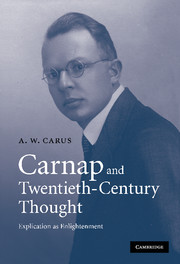Book contents
- Frontmatter
- Contents
- Preface
- Note on the style of citation
- Introduction
- 1 The cultural inheritance
- 2 The intellectual inheritance: positivism and Kantianism
- 3 The grand plan of a ‘system of knowledge’: science and logic
- 4 Carnap's early neo-Kantianism
- 5 The impact of Russell
- 6 Rational reconstruction
- 7 The impact of Wittgenstein
- 8 The crisis of rational reconstruction, 1929–1930
- 9 Liberation
- 10 Tolerance
- 11 The ideal of explication
- Bibliography
- Index
9 - Liberation
Published online by Cambridge University Press: 22 September 2009
- Frontmatter
- Contents
- Preface
- Note on the style of citation
- Introduction
- 1 The cultural inheritance
- 2 The intellectual inheritance: positivism and Kantianism
- 3 The grand plan of a ‘system of knowledge’: science and logic
- 4 Carnap's early neo-Kantianism
- 5 The impact of Russell
- 6 Rational reconstruction
- 7 The impact of Wittgenstein
- 8 The crisis of rational reconstruction, 1929–1930
- 9 Liberation
- 10 Tolerance
- 11 The ideal of explication
- Bibliography
- Index
Summary
On 21 January 1931 Carnap came down with a flu, and hardly slept that night. While tossing and turning, he had an idea how to escape the predicament described in the last two chapters. When he got up the next morning, he sat down and sketched an outline. The title he put down was ‘Versuch einer Metalogik ’ (‘Attempt at a metalogic’). He calls it by the same name, then, that he had given his effort at a ‘general axiomatics’ a few years earlier (above, Chapter 7, note 5). In both cases, the allusion was to Hilbert's ‘meta-mathematics’. But in the first case, as we saw, the object of the ‘meta-logic’ had been to assimilate Hilbert's meta-mathematics into the object language, i.e. into a logicist framework. So the ‘meta-logic’ of 1927–9 had not really been ‘meta’. All the object languages within the scope of the General Axiomatics had been situated in a ‘basic system’, which defined a single language that adumbrated both meta-language and object language. But now, in January 1931, the ‘meta-logic’ is genuine.
This was not simply a return, of course, to where he had been in 1926 or before; the Wittgensteinian captivity had left its mark, and the meta-logic that emerged in early 1931 was a chastened one. The requirement that meta-discourse remain internal to a single language system (of object language and a specific hierarchy of meta-languages) remained in force.
- Type
- Chapter
- Information
- Carnap and Twentieth-Century ThoughtExplication as Enlightenment, pp. 229 - 251Publisher: Cambridge University PressPrint publication year: 2007

